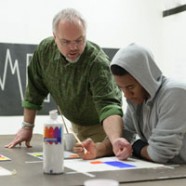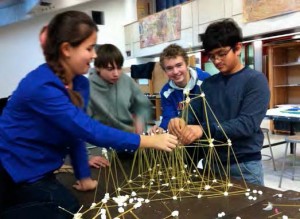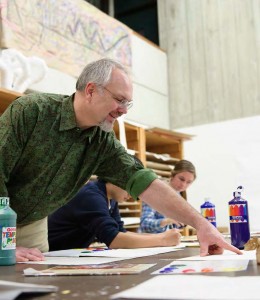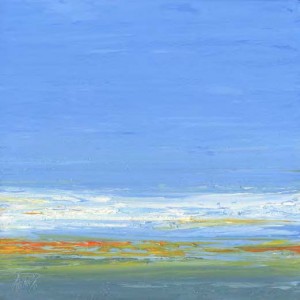
Ian Torney, Class of 1982—accomplished oil painter and arts educator—has returned to Milton’s art classrooms. Next year he will lead the visual arts department as its chair. The department’s approach to working with students has not changed since his time as a student, and Ian quickly names this underlying asset: “I am inheriting a department with a clear point of view,” he says. “Gordon Chase, Bryan Cheney, Anne Neely, Paul Menneg and Maggie Stark, my former teachers, deserve credit for establishing a contemporary way of teaching art here, a method ahead of its time.”
The department’s faculty believe that students learn skills through wrestling with an idea. The “creative problem” comes first, as does thinking critically about how to solve that problem with the tools at hand. Then comes the focus on particular artistic techniques. In the past, painters, photographers and sculptors studied within their own silos, Ian points out. Today, artists create across boundaries, and technology has become a major integrative agent. “Today, a painter who isn’t comfortable and competent with technology is remiss,” Ian says.

Ian charged his Class IV students with constructing the largest, most durable sculpture they could, using marshmallows and dry spaghetti, exclusively. Students worked “in the tradition of Buckminster Fuller (Milton Class of 1913) and his geodesic dome,” Ian says.
Art classes for Class IV students are a case in point. Class IV should be a year of hands-on experience, exploration and risk taking, the department thinks. One semester, students have a weekly double period in the visual arts; they address drawing, painting, sculpture and digital imaging. The same schedule in performing arts applies during the alternate semester.
“Our introduction to sculpture, for instance, is presenting material and a problem. While students work through the making and doing, I talk through design principles and offer relevant context and history,” Ian says. In one session last fall, students’ “materials” were marshmallows and dry spaghetti. Using these, they were to construct the largest sculpture they could that would survive the trip back to dorm or to home, intact. They worked “in the tradition of Buckminster Fuller (Milton Class of 1913) and his geodesic dome,” Ian says. These sculptures served as maquettes for the design challenge in the next class: working as a group, with only two Sunday-newspaper’s worth of newsprint and one roll of masking tape, to build as tall a tower as possible, strong enough to hold the weight of a teddy bear at the top.
 “In the Class IV program, we’re not necessarily after a certain finished product—we’re more interested in the process. I put a creative problem before the students. If there are 12 people in the class, I want 12 different responses.”
“In the Class IV program, we’re not necessarily after a certain finished product—we’re more interested in the process. I put a creative problem before the students. If there are 12 people in the class, I want 12 different responses.”
This approach is pedagogically on target for freshmen, Ian thinks. After this broad exposure, students begin to understand the possibilities of different art disciplines and get excited about focusing on an area for a full-year course. (Milton requires at least one full-year course in the arts.)
In successive courses, Class III and beyond, students narrow their focus and intensively develop certain skills crucial to a particular art discipline. In a typical class that meets several times a week, students and their faculty can be more deliberate and formal about developing extended projects. “Students also see how what they’re doing in art intersects with all the subject areas they’re studying,” Ian points out.
“Working to develop one visual concept over the course of a semester—pushing one big idea as far as it can go—is an important experience for young people, especially when they hit the wall and have to push through it,” Ian says.
Advancing his own work and his technique in oil painting led Ian from what he calls “fairly traditional, realistic landscape painting” to “more abstract, atmospheric works.” His current work, for instance, focuses on the ambiguity found at the horizon. Texture and the relief of the surface is important now. He uses a palette knife almost exclusively to deliver the paint and focuses on how the mark affects the surface of the painting.
Art is always about problem solving, and for Ian the genesis of an idea is often a small plein-air study (12″ x 12″) that he translates into a much larger composition. Executing the difference in scale presents many challenges, especially as his technique requires him to work on a wet surface. “The sculptural possibilities inherent in the slow-drying attributes of oil paint are integral to my work,” he says, “and the medium really leads the process.”

At The Horizon: orange and blue sky. Oil on board, 12x12 inches, 2011. Ian created this painting for his exhibit at the Nesto Gallery last spring.
Ian has plenty of energy and ideas for the visual arts curriculum, including one that will get under way in the coming year—a seminar course titled “Master Projects.” Ian plans to integrate the Nesto Gallery and its exhibiting artists into the academic program vigorously. “Nesto Gallery artists, along with Milton faculty (all practicing artists themselves), will lead students in master projects around the tenets of their distinct practices,” Ian explains. “The artist’s media and method of working will shape the kinds of projects students undertake.” Ian also believes that “the Art and Media Center (the old science building) has tremendous possibility. The space naturally lends itself to our discipline; we’ll continue to repurpose the building for visual arts even as we use it.”
Each of the arts is a distinct discipline, but learning about them from an integrative, problem-solving point of view is a powerful teaching method, Ian thinks, framing the department’s point of view. “Arts can easily take a leading position in learning experiences, in developing technical abilities, understanding historical context, and cultivating critical thinking along with creativity,” Ian says. “The arts can be more adaptable and nimble—embrace what’s coming, as well as what’s been. Teachers do not ‘teach to the test,’ the burden in many academic areas.
“Our approach as a department is culturally consistent with this School,” Ian points out. “Milton students are not shy. They’re creative and curious and ready to engage, and Milton does a terrific job of supporting those attributes in our students.”
—Cathleen D. Everett



